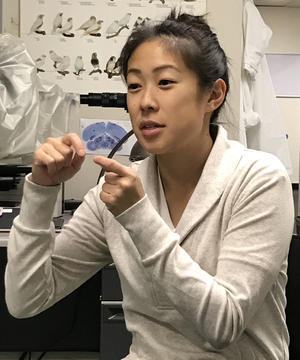Former Lab Members
Rachel Yuan
Motor skill learning during development entails a process of sensorimotor integration involving iterative comparisons between a current behavior and a goal behavior. Vocal learning in songbirds provides a model for investigating how such evaluations are carried out: like humans, songbirds memorize vocal sounds based on auditory experience with vocalizations from adult tutors. During sensorimotor learning, juvenile songbirds compare their own vocalizations to the tutor memory (the goal behavior) and refine their motor program accordingly. My project uses this model to address a fundamental question of goal-directed learning: how does the comparison between a current motor program and a goal behavior take place?

Alex Chung
Vocal learning in songbirds serves as a powerful model for investigating mechanisms of motor skill learning because, like humans, juvenile songbirds learn this complex motor skill from an adult tutor during a sensitive period of development. Vocal learning in juvenile songbirds is mediated by parallel loops that traverse cortex, basal ganglia, and thalamus. The output of sensorimotor processing through these recurrent cortico-basal ganglia circuits is conveyed to vocal motor cortex, whose neurons directly drive vocal motor output.

Amy Paterson
I completed a neuroanatomical tract tracing project as part of my dissertation work. My studies investigated circuits for multimodal sensory integration and bilateral coordination between hemispheres for vocal learning and behavior in zebra finches. You can access the full text of my paper here.

Lauren Eisenman
Procedural skill learning encompasses many forms, from learning to ride a bike to vital skills such as speech. All forms of skill learning involve a stage of practice during which feedback of self-produced behavior is compared to a goal behavior first observed in a mentor. Songbirds, like humans, undergo a protracted period of skill learning during development as they acquire vocal sounds used for communication. Vocal learning comprises two stages: a sensory phase during which juveniles commit to memory the song of a social tutor, and a sensorimotor stage in which they practice their song motor output and compare it to their memorized tutor-song pattern, the goal behavior.
See more.

Jenny Achiro
I discovered a large population of neurons in LMAN-shell that is selectively tuned to each bird’s memorized tutor song. That is an important finding since it represents a neural signature of the goal behavior. I also discovered a population of neurons that respond selectively to each bird’s own immature song; that represents a neural signature of the current state of self-generated behavior. Together these two populations form a basis for making evaluative comparisons between self-generated behavior and the goal behavior.

Dr. Soumya Iyengar
Soumya is now a Professor at the National Brain Research Center in New Delhi. She published three substantive studies as part of her dissertation, looking at developmental changes in the specificity of axonal connections and how they are influened by experience. She made several remarkable discoveries. One was that the projection from LMAN-core to vocal motor cortex lacks topographic specificity during early development, but in young birds that receive normal auditory experience, this connection becomes refined; raising birds in constant white noise prevented the axon remodeling that normally occurs.
